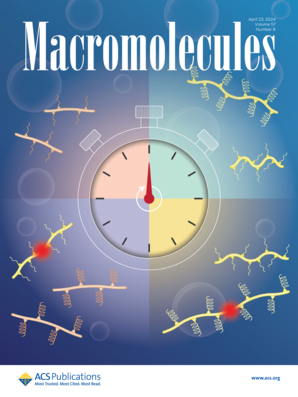Wetting Reveals the Surface Dynamics of Polymer Glasses
IF 5.1
1区 化学
Q1 POLYMER SCIENCE
引用次数: 0
Abstract
The temperature dependence of the dynamic wetting of an immiscible ionic liquid on surfaces of polystyrene (PS), poly(4-methylstyrene) (P4MS), and poly(tert-butylstyrene) (PtBS) films was investigated in this work. Profound stick–slip motions of the droplets were observed near the glass transition temperature (Tg) of the polymers, where energy dissipation is significant. Additionally, an unexpected stick–slip motion with a small amplitude was observed at ∼60 K below Tg for PtBS and P4MS. This small-but-discernible stick–slip motion below Tg was attributed to the α-relaxation of the mobile surfaces of the polymer glasses. The surface activation energy, derived from the frequency dependence of the low-temperature stick–slip motion, was ∼150 kJ/mol, which is substantially lower than the activation energy for bulk polymers. However, no stick–slip motion was observed on PS films below Tg, likely due to the lowered surface mobility and/or reduced surface layer thickness of PS compared to PtBS and P4MS, implying a greater enhancement on the surface mobility for polymer glasses bearing bulkier side groups. Our results reinforce the idea of the presence of a mobile surface layer on polymer glasses and demonstrate that dynamic wetting is a sensitive indicator for surface relaxation of polymer glasses.

润湿揭示了聚合物玻璃的表面动力学
研究了不混溶离子液体在聚苯乙烯(PS)、聚4-甲基苯乙烯(P4MS)和聚叔丁基苯乙烯(PtBS)薄膜表面动态润湿的温度依赖性。在聚合物的玻璃化转变温度(Tg)附近,观察到液滴的深刻粘滑运动,能量耗散显著。此外,PtBS和P4MS在低于Tg的~ 60 K处观察到意想不到的小幅度粘滑运动。这种微小但明显的粘滑运动是由于聚合物玻璃的活动表面的α-弛豫。从低温粘滑运动的频率依赖性得出的表面活化能为~ 150 kJ/mol,这大大低于体聚合物的活化能。然而,在Tg以下的PS薄膜上没有观察到粘滑运动,这可能是由于与PtBS和P4MS相比,PS的表面迁移率降低和/或表面层厚度减少,这意味着具有较大侧基的聚合物玻璃的表面迁移率有更大的增强。我们的结果加强了聚合物玻璃上存在可移动表面层的想法,并证明动态润湿是聚合物玻璃表面松弛的敏感指标。
本文章由计算机程序翻译,如有差异,请以英文原文为准。
求助全文
约1分钟内获得全文
求助全文
来源期刊

Macromolecules
工程技术-高分子科学
CiteScore
9.30
自引率
16.40%
发文量
942
审稿时长
2 months
期刊介绍:
Macromolecules publishes original, fundamental, and impactful research on all aspects of polymer science. Topics of interest include synthesis (e.g., controlled polymerizations, polymerization catalysis, post polymerization modification, new monomer structures and polymer architectures, and polymerization mechanisms/kinetics analysis); phase behavior, thermodynamics, dynamic, and ordering/disordering phenomena (e.g., self-assembly, gelation, crystallization, solution/melt/solid-state characteristics); structure and properties (e.g., mechanical and rheological properties, surface/interfacial characteristics, electronic and transport properties); new state of the art characterization (e.g., spectroscopy, scattering, microscopy, rheology), simulation (e.g., Monte Carlo, molecular dynamics, multi-scale/coarse-grained modeling), and theoretical methods. Renewable/sustainable polymers, polymer networks, responsive polymers, electro-, magneto- and opto-active macromolecules, inorganic polymers, charge-transporting polymers (ion-containing, semiconducting, and conducting), nanostructured polymers, and polymer composites are also of interest. Typical papers published in Macromolecules showcase important and innovative concepts, experimental methods/observations, and theoretical/computational approaches that demonstrate a fundamental advance in the understanding of polymers.
 求助内容:
求助内容: 应助结果提醒方式:
应助结果提醒方式:


